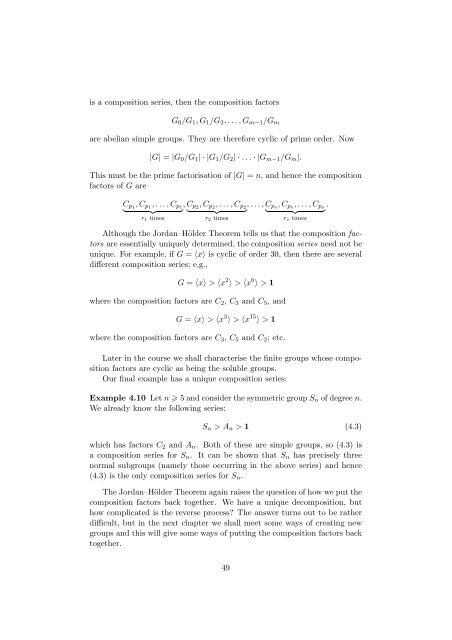The JordanâHölder Theorem
The JordanâHölder Theorem
The JordanâHölder Theorem
You also want an ePaper? Increase the reach of your titles
YUMPU automatically turns print PDFs into web optimized ePapers that Google loves.
is a composition series, then the composition factors<br />
G 0 /G 1 ,G 1 /G 2 ,...,G m−1 /G m<br />
are abelian simple groups. <strong>The</strong>y are therefore cyclic of prime order. Now<br />
|G| = |G 0 /G 1 |·|G 1 /G 2 |·...·|G m−1 /G m |.<br />
This must be the prime factorisation of |G| = n, andhencethecomposition<br />
factors of G are<br />
C p1 ,C p1 ,...,C p1 ,C p2 ,C p2 ,...,C p2 ,...,C ps ,C ps ,...,C ps .<br />
} {{ } } {{ } } {{ }<br />
r 1 times<br />
r 2 times<br />
r s times<br />
Although the Jordan–Hölder <strong>The</strong>orem tells us that the composition factors<br />
are essentially uniquely determined, the composition series need not be<br />
unique. For example, if G = 〈x〉 is cyclic of order 30, then there are several<br />
different composition series; e.g.,<br />
G = 〈x〉 > 〈x 2 〉 > 〈x 6 〉 > 1<br />
where the composition factors are C 2 , C 3 and C 5 ,and<br />
G = 〈x〉 > 〈x 3 〉 > 〈x 15 〉 > 1<br />
where the composition factors are C 3 , C 5 and C 2 ;etc.<br />
Later in the course we shall characterise the finite groups whose composition<br />
factors are cyclic as being the soluble groups.<br />
Our final example has a unique composition series:<br />
Example 4.10 Let n 5andconsiderthesymmetricgroupS n of degree n.<br />
We already know the following series:<br />
S n >A n > 1 (4.3)<br />
which has factors C 2 and A n . Both of these are simple groups, so (4.3) is<br />
acompositionseriesforS n . It can be shown that S n has precisely three<br />
normal subgroups (namely those occurring in the above series) and hence<br />
(4.3) is the only composition series for S n .<br />
<strong>The</strong> Jordan–Hölder <strong>The</strong>orem again raises the question of how we put the<br />
composition factors back together. We have a unique decomposition, but<br />
how complicated is the reverse process <strong>The</strong> answer turns out to be rather<br />
difficult, but in the next chapter we shall meet some ways of creating new<br />
groups and this will give some ways of putting the composition factorsback<br />
together.<br />
49













